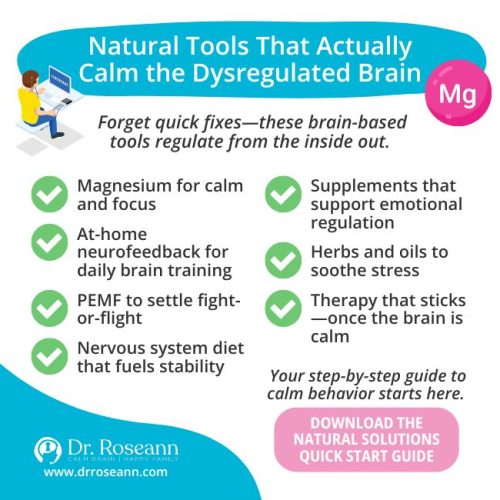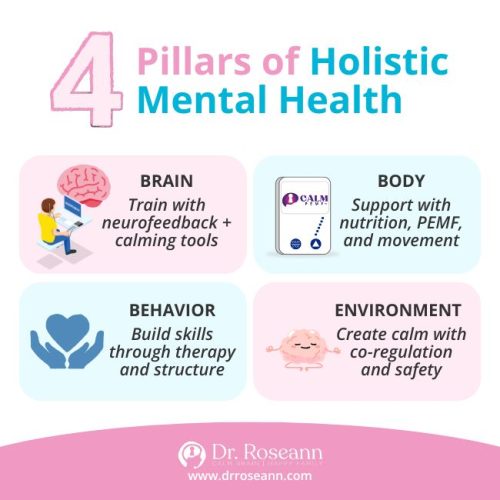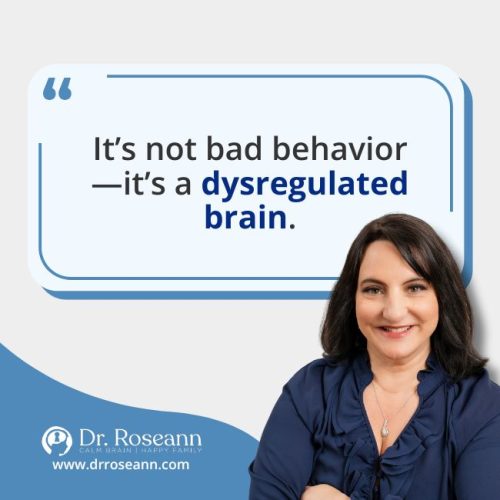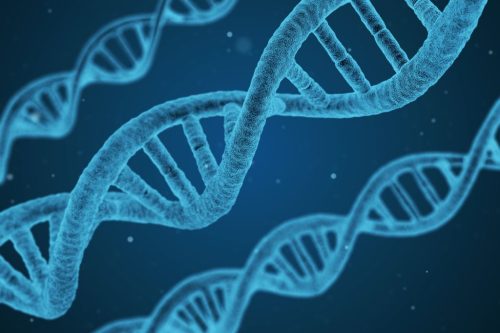Estimated reading time: 11 minutes
The holistic approach to mental health every parent needs to know.
If your child is struggling with focus, mood swings, meltdowns, or anxiety, it might feel like you’re chasing symptoms and never getting to the root. You’ve tried therapy. You’ve considered medication. But deep down, you know there must be a more natural, whole-child way to help your child thrive.
A holistic approach to mental health looks at the brain, body, and environment. It’s not just about managing behaviors—it’s about calming the nervous system and healing the underlying dysregulation that’s fueling the chaos.
In this blog, we’ll explore nine essential pillars that can support your child’s brain and body from the inside out. Whether you’re new to natural solutions or already experimenting with alternatives, this guide will give you a clear, research-backed roadmap.

What Is a Holistic Approach to Mental Health in Children?
A holistic approach means we look at the whole child—brain, body, behaviors, and environment. That means we don’t just zero in on one diagnosis or symptom; we zoom out to see what’s really going on underneath the surface.
If you’ve ever felt like you’re playing whack-a-mole with your child’s behaviors—as soon as you handle one issue, another pops up—you’re not alone. That’s what happens when we only treat the symptoms.
Instead, we focus on why the dysregulation is happening and create a plan that supports the nervous system from the inside out. We’re not just managing the chaos—we’re teaching the brain how to find calm.
Core principles of holistic mental health:
- The brain can change (neuroplasticity is real!)
- The nervous system is the foundation of behavior
- Natural and science-backed therapies support healing
- Parent regulation is just as important as child regulation
You might be a parent who feels pulled in a million directions, unsure how to begin supporting your child naturally. The good news? You don’t have to do everything at once. Starting with nervous system regulation and nutrition isn’t just effective—it’s doable, even in a busy family life. You can begin with simple steps, like adding magnesium at bedtime or creating a calming morning routine, and build from there.

How Does Neurofeedback Help Kids With Emotional Dysregulation?
Neurofeedback is a non-invasive, drug-free way to train the brain to self-regulate. Using EEG technology, we identify which brain areas are under- or overactive and gently guide the brain toward better balance and functioning.
What’s especially exciting for parents is that neurofeedback is now available at home. With safe, easy-to-use devices like those in our BrainBehaviorReset® Program, you can train your child’s brain right in your living room—no waiting rooms, no stressful commutes, and no rigid therapy schedules.
It’s empowering because you become an active part of your child’s healing. Daily sessions are short, comfortable, and kid-approved—many parents describe it as a game-changer for emotional regulation and focus.
Benefits of neurofeedback for kids:
- Reduces anxiety, ADHD, OCD, and mood symptoms
- Improves focus, sleep, and behavior
- Creates lasting brain changes with no side effects
When Liam, age 11, started neurofeedback, he was having 3–5 meltdowns a day. Within six weeks, those outbursts dropped to once a week—and he finally felt in control of his body and his family started to regulate too. They were so impressed with the neurofeedback, they decided to have his 19-year old sister with anxiety do it too.
What Are the Benefits of At-Home Neurofeedback?
At-home neurofeedback makes brain training more affordable and accessible. With devices like those used in our BrainBehaviorReset® Program, you can support your child from the comfort of home.
Why parents love at-home neurofeedback:
- Consistent daily use speeds progress
- Parents get involved in the healing process
- Works for ADHD, anxiety, PANS/PANDAS, and more
- Get access to Dr. Roseann’s expertise in children’s behavior and mental health
At-Home vs. In-Clinic Neurofeedback
| Feature | In-Clinic Neurofeedback | At-Home Neurofeedback with Dr. Roseann |
|---|---|---|
| Location | Clinic-based sessions | Comfort of your own home |
| Parental Involvement | Minimal | High — parents play an active role |
| Flexibility | Scheduled appointments only | Flexible, can be done on your child’s schedule |
| Child Comfort | New or unfamiliar setting | Familiar environment reduces stress |
| Consistency | Depends on clinic schedule | More frequent sessions mean faster results |
| Expert Oversight | In-person clinician monitors progress | Guided and supported by Dr. Roseann’s clinical team |
| Accessibility | Requires commuting and time off | Easy access from anywhere, no travel required |
What Is PEMF Therapy and Can It Help My Child?
PEMF stands for Pulsed Electromagnetic Field Therapy. It sends low-frequency waves into the body that calm the nervous system, improve cellular health, and reduce inflammation.
Our CALM PEMF® device was designed specifically for sensitive, neurodivergent kids.
Benefits of PEMF Therapy:
- Calms fight-or-flight response
- Supports sleep and mood
- Helps regulate behavior without medication
Dr. Roseann’s Therapist Tip “In my 30+ years of clinical practice, I’ve learned that calming the nervous system is step one. Here’s what I tell parents: If your child is stuck in ‘on’ mode, their brain can’t learn or listen.** Try this today**: 5–10 minutes of PEMF while reading or snuggling. Why it works: PEMF helps the parasympathetic nervous system activate, which allows the brain to reset. Remember: Let’s calm the brain first.”
What Types of Therapy Are Best for Dysregulated Kids?
Traditional talk therapy isn’t always the best fit for kids with emotional dysregulation, especially when their nervous system is in a constant state of fight, flight, or freeze. Before any therapy for kids can be effective—whether it’s cognitive, behavioral, or emotional—the nervous system must be regulated first.
When the brain is calm, children can absorb coping strategies, connect with a therapist, and actually benefit from therapeutic work. Without that foundation, even the best therapy can feel like it’s going nowhere.
That’s why we start with nervous system supports like neurofeedback, PEMF, and nutritional support. Once the brain is calmer and more receptive, therapy becomes far more effective and can lead to meaningful, lasting change.
Effective therapy for kids types include:
- Cognitive behavioral therapy (CBT) with parent involvement
- Somatic or sensory-based therapies (like OT or movement therapy)
- Exposure and Response Prevention (ERP) for OCD
- Family systems or parent coaching support
- Play therapy
- Behavioral Therapy

Can Magnesium Really Help Children With Anxiety or ADHD?
Yes—and not all magnesium is created equal. When it comes to magnesium for kids, the form and quality matter. Magnesium L-Threonate crosses the blood-brain barrier to support cognitive function. Magnesium Glycinate is gentle on the stomach and ideal for calming anxiety, while Magnesium Malate helps with mood and energy production.
These forms are particularly helpful for calming the brain, reducing reactivity, and improving focus—especially in children with ADHD, anxiety, or emotional dysregulation. When combined with other natural supports like diet and neurofeedback, magnesium becomes a powerful tool in your child’s regulation toolkit.
Benefits of magnesium for children:
- Reduces hyperactivity and anxiety
- Helps with sleep and irritability
- Supports focus and emotional regulation
Kathy, mom of 15-year-old Leo with ADHD, had tried everything—elimination diets, reward charts, even switching schools. Nothing seemed to help with his explosive outbursts and constant restlessness. Within just one week of starting Neurotastic Multi-Mag Brain® Formula, she noticed something different: Leo was less reactive, falling asleep faster, and waking up in a calmer mood.
She said, “It felt like his nervous system finally got the memo to chill out.” For the first time, therapy sessions were actually helping because his brain wasn’t stuck in high-alert mode. This is what the right magnesium for kids can do when it’s targeted to the brain’s needs.
Which Essential Oils Help Regulate the Nervous System?
Essential oils for nervous system may seem trendy, but there’s real science behind how they support the nervous system. When a child is dysregulated, their brain is flooded with stress hormones, making it nearly impossible to focus, sleep, or stay calm. That’s where essential oils come in—they offer gentle, natural support that helps shift the nervous system from “stuck on” to settled and safe.
When used safely and consistently, oils like lavender, vetiver, frankincense, and chamomile can reduce stress responses, calm racing thoughts, and make transitions like bedtime or schoolwork less overwhelming.
Many parents I work with tell me they were skeptical at first—but after a few nights of using calming oils as part of their child’s wind-down routine, they saw the difference: fewer bedtime battles, fewer tears, and a smoother start to the day. Essential oils are one of those small changes that, when used with intention, can make a big impact.
Use essential oils for regulating the nervous system:
- Calming bedtime routines
- Morning regulation rituals
- Focus support during schoolwork
VISUAL: Graphic: Best Essential Oils for Regulation by Use (Sleep, Calm, Focus)
- Alt text: Table of oils and their purposes
- Placement: After this section
What Herbs Are Good for Children’s Mental Health?
Herbs for mental health have been used for centuries to calm the body and support emotional well-being. For parents of dysregulated kids, this can feel like a much-needed lifeline—especially when you’re exhausted from trying so many things that just don’t stick.
When the nervous system is stuck in overdrive, gentle, brain-supportive herbs can help shift your child into a calmer, more balanced state. While not all herbs are safe for children, these gentle, effective options can reduce reactivity, soothe stress, and support better sleep—making your parenting job just a little bit easier.
As I always say: if we calm the nervous system, we open the door to healing. And herbs are one of those natural tools that can give kids that first step toward balance.
- Chamomile: Soothes irritability
- Lemon Balm: Calms nervous energy
- Ashwagandha (low dose): Supports stress tolerance
- Holy Basil: Balances cortisol
Important: Always consult your provider before introducing herbs.
When Tina added chamomile tea to her 7-year-old’s nightly routine, she saw fewer bedtime battles and deeper sleep.
Nervous System Supplements for Kids
| Supplement | Main Benefits |
|---|---|
| Magnesium (L-Threonate, Glycinate, Malate) In Neurotasti ® Multi-Mag Brain® Formula | Calms the brain Improves sleep Boosts focus |
| Omega-3s (DHA-rich) | Reduces brain inflammation
Supports mood & learning |
| L-Theanine | Promotes calm alertness Sharpens focus without sedation |
| NAC (N-Acetyl Cysteine) | Eases irritability
Supports OCD and emotional control |
What Are the Best Nervous System Supplements for Kids?
Sometimes food alone can’t provide all the brain support our kids need—especially when their nervous system has been under stress for a long time. That’s where nervous system supplements can be a game-changer. These science-backed nutrients are designed to support emotional regulation, focus, and stress resilience—so your child can feel more calm and in control.
But here’s the key: go slow, and go smart. Parents often ask me, “Where do I even start with supplements?” My answer is always: start with the basics, like magnesium or Omega-3s, and layer support gradually. Watch how your child responds. Keep it simple.
And never try to figure it all out alone. Working with a provider who understands how the brain and body are connected—like our team here—can help you avoid overwhelm and choose the right supports, at the right time. Because when the nervous system is nourished, everything else gets easier.
Top brain-supporting supplements:
- Magnesium (L-Threonate, Glycinate, Malate)
- Omega-3s (DHA-rich)
- L-Theanine (for calm alertness)
- NAC (for OCD and irritability)
Brain Science Spotlight on Holistic Approaches to Mental Health
Recent research from the University of Colorado shows that children with mood and behavioral issues often have lower magnesium and Omega-3 levels. Dr. Erin Brown, lead author of the study published in Child Psychiatry & Human Development, explains: “We found significant improvements in emotional control with targeted nutrient support.”
This helps explain why so many kids feel calmer and more focused after just a few weeks of supplement support.
What this means for your family: Start with one targeted supplement and track your child’s behavior over two weeks. You’ll likely notice better sleep, fewer outbursts, and improved attention.
Nervous System Diet Essentials
| Food Group | Why It Helps |
|---|---|
| Healthy Fats | Boosts brain development & mood |
| Protein | Builds focus chemicals (neurotransmitters) |
| Fiber-Rich Foods | Keeps blood sugar stable |
| Anti-Inflammatory Foods | Lowers brain stress |
| Probiotics & Prebiotics | Supports gut-brain connection |
What Diet Supports a Regulated Nervous System?
What your child eats directly affects how their brain works—and how their body manages stress. A well-balanced nervous system diet helps calm the brain, stabilize mood, and reduce inflammation that contributes to dysregulation.
For parents, this means that food isn’t just fuel—it’s a form of therapeutic support. And it doesn’t have to be perfect. Even small changes, like reducing added sugars or adding in healthy fats, can have a noticeable impact. A nervous system diet is anti-inflammatory, nutrient-dense, and consistent, helping the brain stay more balanced throughout the day.
When your child’s blood sugar is stable and their gut is supported, they’re less likely to crash into meltdown mode. And that means more peaceful mornings, smoother school days, and easier evenings—for everyone in the family.
Key nervous system nutrition tips for the family:
- Avoid artificial dyes, sugars, and additives
- Add healthy fats, protein, and fiber to every meal
- Prioritize real, whole foods: veggies, berries, clean proteins
- Support the gut with fermented foods and prebiotics
What Should Parents Know About the Dangers of Medication?
While medication can be life-saving in some cases, it’s often overprescribed. And it comes with real risks—especially for developing brains. Psychiatric medication should never be the first line of defense for a developing child. There are safer, natural, and science-backed ways to support the brain and body first.
This guide gives you exactly that: real solutions that regulate the nervous system using tools like nutrition, supplements, neurofeedback, and PEMF. And here’s the key—when the nervous system is regulated, everything improves: focus sharpens, mood stabilizes, and learning becomes possible.
Common medication side effects in kids:
- Sleep problems, appetite suppression, and emotional blunting
- Increased anxiety, mood swings, or tics
- Rebound dysregulation and dependency
Before turning to meds, explore root cause healing first.

Is There a Safe, Natural Plan That Actually Works?
Yes! And it starts with calming the brain—because a dysregulated brain can’t learn, connect, or feel safe.
When a child’s nervous system is stuck in fight, flight, or freeze, it hijacks everything: focus, mood, learning, even relationships. That’s why calming the brain must come first. It’s the foundation of every other intervention. Once the nervous system is regulated, your child becomes more open to therapy, more able to follow directions, and more likely to sleep, eat, and engage without daily battles.
The natural strategies in this guide—like magnesium, PEMF, and neurofeedback—aren’t just random wellness tools. They’re grounded in science and designed to do one thing: regulate the nervous system so your child can thrive.
The 5 Pillars of Dr. Roseann’s Brain-First Method:
- Calm the brain with PEMF, magnesium, and oils
- Train the brain with at-home neurofeedback
- Nourish the brain with a nervous system diet and supplements
- Teach the brain with therapy and coping skills
- Support the family with co-regulation and parent modeling
Every child is different—but when we support the nervous system, the brain becomes more receptive to learning, growing, and healing.
So often parents are told to focus on behavior management or jump straight to medication—but the truth is, those approaches won’t stick unless the nervous system is calm. Regulation is the foundation. When the nervous system is soothed, your child is better able to focus, regulate emotions, sleep, and engage with the world around them.
That’s exactly what The Natural Solution Quick Start Guide was created to help with—giving you the first, most effective steps toward helping your child feel better without meds. Start here, and you’ll start to see change.
FAQs for Holistic Approaches to Mental Health
What is the best natural supplement for kids with ADHD?
Magnesium and Omega-3s are two of the most effective, well-researched options.
Are essential oils safe for young children?
Yes, when used properly. Always dilute and avoid ingesting oils.
How long does it take to see results with neurofeedback?
Most children show improvement in 6 to 20 sessions.
Can diet really affect behavior?
Absolutely! The gut-brain connection is powerful. A clean diet often reduces meltdowns.
Should I stop medication to try natural treatments?
Never stop meds abruptly. Talk to your provider and develop a transition plan.
Terminology
- Neurofeedback: A therapy that uses real-time brainwave feedback to improve regulation
- PEMF: Pulsed Electromagnetic Field Therapy that calms the nervous system
- Dysregulation: When a child’s brain or emotions become overwhelmed and reactive
- Co-regulation: When a calm parent helps their child calm down through connection
Citations:
Alsamiri, Y. A., Hussain, M. A., Alsamani, O. A., & Al Bulayhi, A. A. (2024). Promoting mental health and wellbeing as means to prevent disability: a review. Frontiers in public health, 12, 1425535. https://doi.org/10.3389/fpubh.2024.1425535
Giles, C. J., Västhagen, M., van Leuven, L., Edenius, A., Ghaderi, A., & Enebrink, P. (2025). The efficacy of psychological prevention, and health promotion interventions targeting psychological health, wellbeing or resilience among forced migrant children and youth: a systematic review and meta-analysis. European child & adolescent psychiatry, 34(1), 123–140. https://doi.org/10.1007/s00787-024-02424-8
Shafran, R., Bennett, S. D., & McKenzie Smith, M. (2017). Interventions to Support Integrated Psychological Care and Holistic Health Outcomes in Paediatrics. Healthcare (Basel, Switzerland), 5(3), 44. https://doi.org/10.3390/healthcare5030044
Dr. Roseann is a mental health expert in Neurodivergence who is frequently in the media:
- Yahoo!Life Anxious and On-Edge? MDs Share the Best Supplements to Tame Stress Naturally
- The Hero Show Natural Solutions for Children’s Mental Wellness
- Brentwood Home Optimize Slumber – Enhance Sleep Naturally
Always remember… “Calm Brain, Happy Family™”
Disclaimer: This article is not intended to give health advice and it is recommended to consult with a physician before beginning any new wellness regime. *The effectiveness of diagnosis and treatment vary by patient and condition. Dr. Roseann Capanna-Hodge, LLC does not guarantee certain results.
Are you looking for SOLUTIONS for your struggling child or teen?
Dr. Roseann and her team are all about science-backed solutions, so you are in the right place!
© Dr. Roseann Capanna-Hodge








